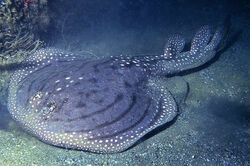(Adding categories) |
No edit summary |
||
| Line 10: | Line 10: | ||
|species = '''Electrolux addisoni''' |
|species = '''Electrolux addisoni''' |
||
|statusimage = CR |
|statusimage = CR |
||
| ⚫ | |status = Critically Endangered}}The '''Ornate sleeper-ray''' ('''Electrolux addisoni'''), is a new species of [[Narkidae|sleeper ray]] in the family [[Narkidae]], and the only member of the genus '''Electrolux'''. It lives on [[wikipedia:Reef|reefs]] feeding on [[Polychaeta|polychaete worms]] and small [[Crustacea|crustaceans]], it has only been seen by divers to feed during the daytime. It is endemic to the coast of [[wikipedia:South Africa|South Africa]]. It was first recorded in 1984 but was not described until 2007. It was ranked as the number one newly described species of 2007 by the [[International Institute for Species Exploration]]. |
||
| − | |status = Critically Endangered}} |
||
| ⚫ | The '''Ornate sleeper-ray''' ('''Electrolux addisoni'''), is a new species of [[Narkidae|sleeper ray]] in the family [[Narkidae]], and the only member of the genus '''Electrolux'''. It lives on [[wikipedia:Reef|reefs]] feeding on [[Polychaeta|polychaete worms]] and small [[Crustacea|crustaceans]], it has only been seen by divers to feed during the daytime. It is endemic to the coast of [[wikipedia:South Africa|South Africa]]. It was first recorded in 1984 but was not described until 2007. It was ranked as the number one newly described species of 2007 by the [[International Institute for Species Exploration]]. |
||
==Description== |
==Description== |
||
The ornate sleeper-ray is easily distinguished from other narkids by its striking colour pattern consisting of a dark brown dorsal surface of the disc with numerous small pale yellow spots and a series of concentric black stripes. It can also be distinguished by its large spiracular papillae. It and [[Heteronarce]] are the only genera in the family Narkidae that have two [[Dorsal Fin|dorsal fins]]. The conspicuous colour pattern of the species may act as a [[Aposematism|warning signal]] to other animals, when closely approached the ray has been seen to make a possible threat display. The holotype pictured weighed 1.8 kg and had a total length of 515 mm. This makes it one of the largest species of Narkidae recorded, although no female specimens have been collected and measured. |
The ornate sleeper-ray is easily distinguished from other narkids by its striking colour pattern consisting of a dark brown dorsal surface of the disc with numerous small pale yellow spots and a series of concentric black stripes. It can also be distinguished by its large spiracular papillae. It and [[Heteronarce]] are the only genera in the family Narkidae that have two [[Dorsal Fin|dorsal fins]]. The conspicuous colour pattern of the species may act as a [[Aposematism|warning signal]] to other animals, when closely approached the ray has been seen to make a possible threat display. The holotype pictured weighed 1.8 kg and had a total length of 515 mm. This makes it one of the largest species of Narkidae recorded, although no female specimens have been collected and measured. |
||
| Line 19: | Line 18: | ||
[[Category:Chondrichthyes]] |
[[Category:Chondrichthyes]] |
||
[[Category:Animals Described in 2007]] |
[[Category:Animals Described in 2007]] |
||
| − | [[Category:Critically Endangered Species]] |
||
| − | [[Category:Chordata]] |
||
[[Category:Fish]] |
[[Category:Fish]] |
||
Revision as of 16:06, 13 August 2020
| Ornate Sleeper-ray | |
|---|---|
 | |
| Information | |
| Range | South Africa, Coffee Bay, Eastern Cape Province, to just north of Durban, kwaZulu-Natal in water less than 50m deep. |
| Scientific Classification | |
| Kingdom | Animalia |
| Phylum | Chordata |
| Class | Chondrichthyes |
| Order | Torpediniformes |
| Family | Narkidae |
| Genus | Electrolux |
| Species | Electrolux addisoni |
| Conservation Status | |
 Critically Endangered | |
The Ornate sleeper-ray (Electrolux addisoni), is a new species of sleeper ray in the family Narkidae, and the only member of the genus Electrolux. It lives on reefs feeding on polychaete worms and small crustaceans, it has only been seen by divers to feed during the daytime. It is endemic to the coast of South Africa. It was first recorded in 1984 but was not described until 2007. It was ranked as the number one newly described species of 2007 by the International Institute for Species Exploration.
Description
The ornate sleeper-ray is easily distinguished from other narkids by its striking colour pattern consisting of a dark brown dorsal surface of the disc with numerous small pale yellow spots and a series of concentric black stripes. It can also be distinguished by its large spiracular papillae. It and Heteronarce are the only genera in the family Narkidae that have two dorsal fins. The conspicuous colour pattern of the species may act as a warning signal to other animals, when closely approached the ray has been seen to make a possible threat display. The holotype pictured weighed 1.8 kg and had a total length of 515 mm. This makes it one of the largest species of Narkidae recorded, although no female specimens have been collected and measured.
Conservation
As this species has only been recorded in four locations its conservation status is unknown but the authors of the paper describing the species recommend that it needs to be critically assessed. Its habitat is intensively used for recreational diving, commercial fishing and there is increasing development along the coastline which means that it may be at risk from pollution, habitat degradation and from being disturbed by divers. The describing authors tentatively suggest that it may possibly be critically endangered but conclude that more observations need to be made before its conservation status can be properly assessed.
